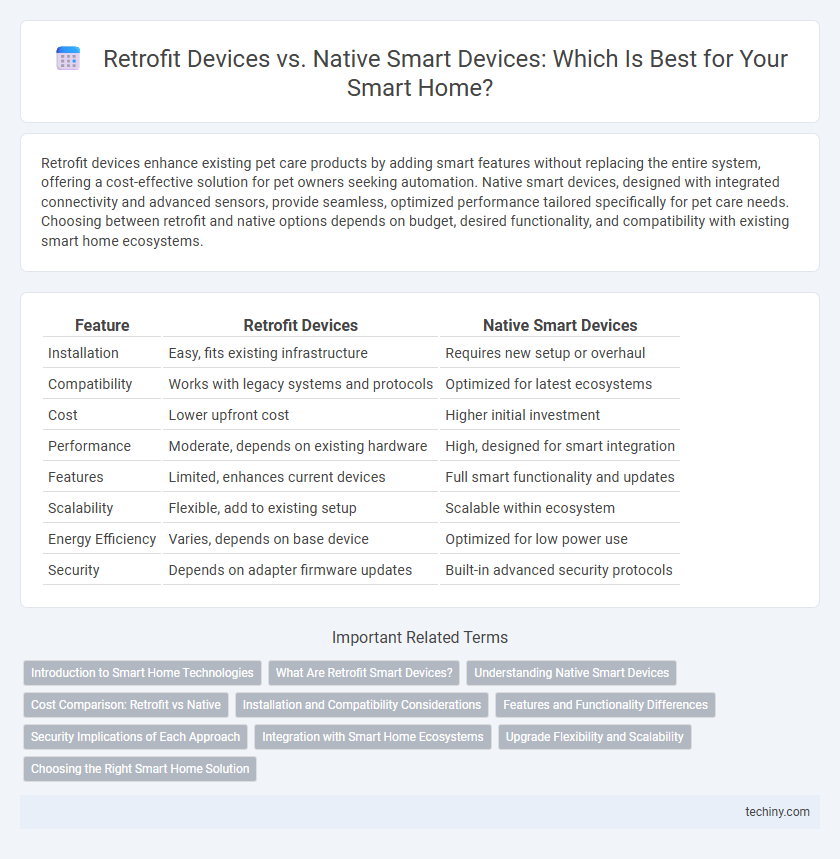Retrofit devices enhance existing pet care products by adding smart features without replacing the entire system, offering a cost-effective solution for pet owners seeking automation. Native smart devices, designed with integrated connectivity and advanced sensors, provide seamless, optimized performance tailored specifically for pet care needs. Choosing between retrofit and native options depends on budget, desired functionality, and compatibility with existing smart home ecosystems.
Table of Comparison
| Feature | Retrofit Devices | Native Smart Devices |
|---|---|---|
| Installation | Easy, fits existing infrastructure | Requires new setup or overhaul |
| Compatibility | Works with legacy systems and protocols | Optimized for latest ecosystems |
| Cost | Lower upfront cost | Higher initial investment |
| Performance | Moderate, depends on existing hardware | High, designed for smart integration |
| Features | Limited, enhances current devices | Full smart functionality and updates |
| Scalability | Flexible, add to existing setup | Scalable within ecosystem |
| Energy Efficiency | Varies, depends on base device | Optimized for low power use |
| Security | Depends on adapter firmware updates | Built-in advanced security protocols |
Introduction to Smart Home Technologies
Retrofit devices enable existing home appliances to gain smart functionality through add-on modules, offering a cost-effective solution without full replacement. Native smart devices are designed with built-in connectivity and advanced features for seamless integration and enhanced user experience. Choosing between retrofit and native smart devices depends on factors like budget, compatibility, and desired automation complexity.
What Are Retrofit Smart Devices?
Retrofit smart devices are existing home appliances and systems upgraded with smart technology through add-on modules or controllers, enabling features like remote control and automation without full replacement. These devices integrate with smart home ecosystems using sensors, Wi-Fi modules, or Zigbee controllers to enhance functionality economically. Retrofit options preserve original hardware while providing compatibility with voice assistants and smart hubs, offering a cost-effective smarter home solution.
Understanding Native Smart Devices
Native smart devices integrate seamlessly with a smart home ecosystem through built-in connectivity and compatibility with major platforms like Google Home, Amazon Alexa, or Apple HomeKit, enabling advanced automation and real-time control. These devices typically offer higher reliability, better security features, and more frequent software updates compared to retrofit options, as they are designed specifically for smart functionality from the ground up. Choosing native smart devices enhances user experience by ensuring smooth interoperability and leveraging the full potential of smart home technology.
Cost Comparison: Retrofit vs Native
Retrofit devices generally offer a cost-effective alternative by upgrading existing appliances without the need for full replacement, often costing 30-50% less than native smart devices. Native smart devices, while more expensive upfront, integrate seamlessly with smart home ecosystems, providing advanced features and longer-term reliability that can reduce maintenance costs. Choosing between retrofit and native smart devices depends on budget constraints and desired functionality, with retrofit solutions suitable for incremental upgrades and native devices best for comprehensive smart home integration.
Installation and Compatibility Considerations
Retrofit devices offer the advantage of easy installation by integrating with existing home infrastructure, eliminating the need for complete system replacement. Native smart devices provide seamless compatibility and optimal performance through manufacturer-designed integration but often require more complex initial setup. Homeowners must weigh retrofit convenience against the enhanced functionality and reliability of native smart solutions.
Features and Functionality Differences
Retrofit devices enable upgrading traditional appliances with smart capabilities such as remote control, scheduling, and energy monitoring without replacing existing hardware, offering cost-effective customization. Native smart devices integrate advanced features like voice control, seamless ecosystem connectivity, and AI-driven automation directly at the hardware level, delivering enhanced reliability and performance. Retrofit options may face limitations in compatibility and latency, while native devices provide smoother user experiences through optimized firmware and cloud integration.
Security Implications of Each Approach
Retrofit devices often integrate with existing home systems, which can expose vulnerabilities if the original infrastructure lacks robust security protocols, increasing the risk of unauthorized access. Native smart devices, designed with built-in security features and regular firmware updates, typically provide stronger protection against cyber threats and data breaches. However, the centralized nature of native ecosystems may also create single points of failure if compromised, necessitating vigilant network monitoring and device management.
Integration with Smart Home Ecosystems
Retrofit devices offer flexible integration by adding smart functionality to existing appliances, allowing compatibility with platforms like Alexa, Google Home, and Apple HomeKit without full replacement. Native smart devices provide seamless ecosystem integration with optimized performance, automated updates, and direct communication protocols such as Zigbee or Z-Wave. Choosing between retrofit and native depends on desired control depth, system coherence, and long-term smart home expansion plans.
Upgrade Flexibility and Scalability
Retrofit devices offer greater upgrade flexibility by allowing homeowners to integrate smart features into existing appliances without full replacements, enabling incremental scalability. Native smart devices provide seamless compatibility with their ecosystems but often require complete device swaps for significant upgrades. Choosing retrofit solutions supports gradual technology enhancements while native devices excel in optimized performance within their proprietary systems.
Choosing the Right Smart Home Solution
Retrofit devices offer a cost-effective way to upgrade existing home systems with smart functionality, utilizing current wiring and fixtures without extensive renovations. Native smart devices, designed specifically for smart home ecosystems, provide seamless integration, advanced features, and enhanced reliability through direct compatibility with platforms like Google Home or Amazon Alexa. Selecting the right smart home solution depends on budget constraints, compatibility needs, and desired level of control, with retrofit devices ideal for incremental upgrades and native solutions suited for new installations or comprehensive automation.
Retrofit Devices vs Native Smart Devices Infographic

 techiny.com
techiny.com